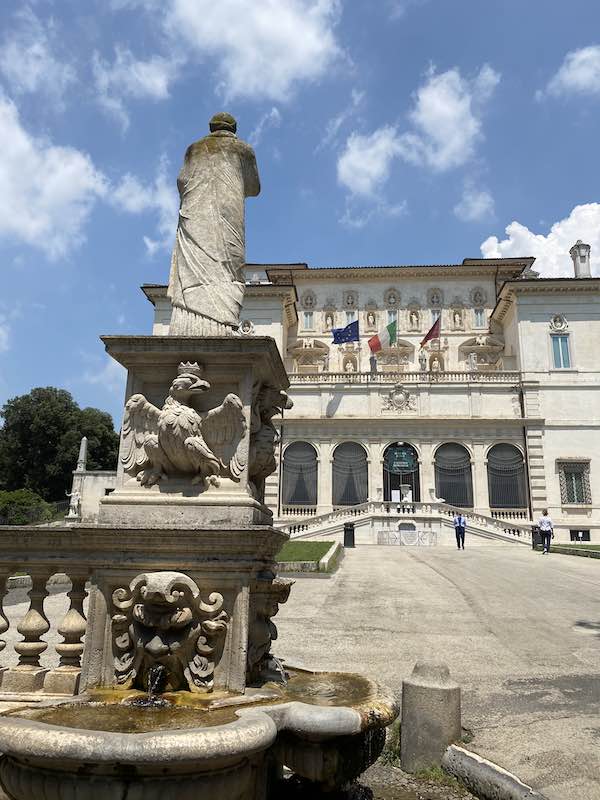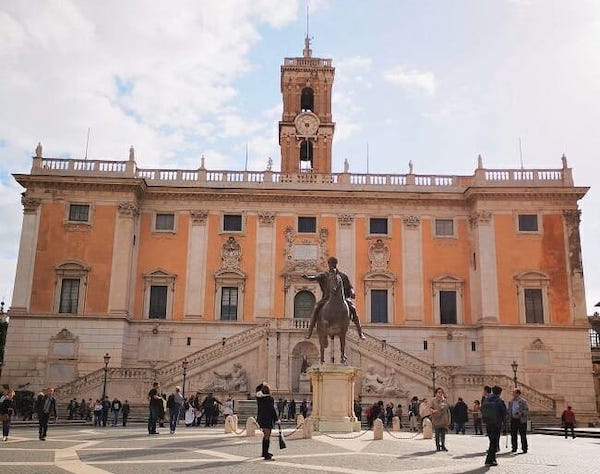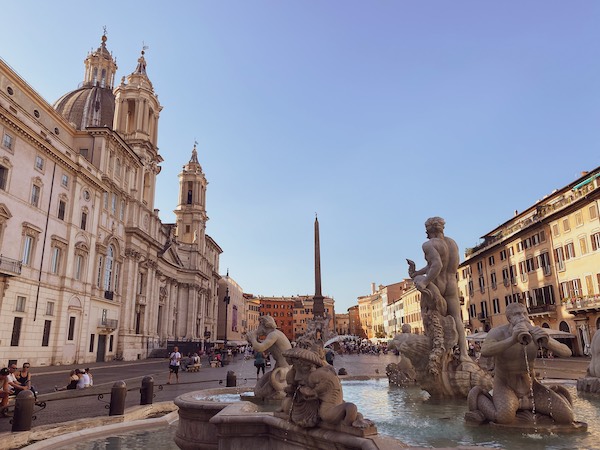Caravaggio in Rome: where and how to see Caravaggio paintings in Rome + map of locations connected to Caravaggio’s life in the Eternal City.
If you love Caravaggio paintings, Rome will be a real treat.
Caravaggio lived in Rome from 1592 to 1606 and left to the city a treasure trove of paintings we can still admire.
Caravaggio paintings are houses in several churches in Rome and many museums. The city also holds many places connected to the life of Caravaggio that are of interest to art lover
In this guide, we look at the list of Caravaggio paintings in Rome, the churches the house them, the best museums for Caravaggio works in Rome and tips for visiting.
Please note: this post contains affiliate links and, should you make a purchase through them, we might make a small commission.

Why see Caravaggio in Rome
Caravaggio spent most of his life in Rome, and the city had a considerable impact on his life, both professionally and personally.
Michelangelo Merisi da Caravaggio was born in Milan in 1571.
In 1592 he moved to Rome and found work with Cavalier d’Arpino, in whose workshop he practiced portraits and ‘flowers and fruit’ as sources recall.
His professional life took a turn for the best when Cardinal Francesco del Monte discovered his work.
The Cardinal introduced him to collectors and the vibrant world of art commissions in Rome, which at that time saw work as significant as the completion of St Peter’s Basilica and the success of baroque architecture.
Despite these professional connections, Caravaggio wasn’t a Bernini friend with the Popes; instead, he is known for being a riotous personality, found in dodgy bars and dangerous company rather than in the salons of the wealthy.
His hot temper brought Caravaggio to fight often and eventually kill a man named Rinuccio Tommasoni.
Sentenced to death by decapitation, Caravaggio fled and spent the rest of his life contemplating his end.
Finally, he died away from Rome in Porto Ercole (Tuscany) in 1610.
Caravaggio’s art is strongly influenced by the people he met in Rome, the world of destitute and prostitutes he frequented and his sentence.
All of them found a place in his art: this is why seeing Caravaggio paintings in Rome is significant. Caravaggio’s work doesn’t just happen to be in Rome; his art is best understood if put into the context of the city, both historically and geographically.
List of Caravaggio paintings in Rome
| Name of Caravaggio work | Date | Location | Free entrance |
| Il Bacchino Malato | 1593-94 | Borghese Gallery | No |
| Giovane con canestro di frutta | 1593-95 | Borghese Gallery | No |
| La Madonna dei Palafrenieri | 1605 | Borghese Gallery | No |
| San Girolamo | 1605-06 | Borghese Gallery | No |
| Davide col la testa di Golia | 1610 | Borghese Gallery | No |
| San Giovanni Battista | 1610 | Borghese Gallery | No |
| Narciso | 1597-99 | Palazzo Barberini | No |
| Giuditta e Oloferne | 1599 | Palazzo Barberini | No |
| San Francesco in Meditazione | 1606-07 | Palazzo Barberini | No |
| Maddalena Penitente | 1594-95 | Galleria Doria Pamphili | No |
| Riposo durante la fuga in Egitto | 1595-96 | Galleria Doria Pamphili | No |
| La Buona Ventura | 1595 | Capitoline Museums | No |
| San Giovanni Battista | 1602-03 | Capitoline Museums | No |
| Ciclo di San Matteo | 1599-1602 | Church of San Luigi dei Francesi | Yes |
| Madonna dei Pellegrini | 1604-06 | Church of Sant’Agostino | Yes |
| Conversione di San Paolo | 1600-01 | Church of Santa Maria del Popolo | Yes |
| Martirio di San Pietro | 1600-01 | Church of Santa Maria del Popolo | Yes |
| La Deposizione | 1600-04 | Pinacoteca Vaticana | No |
| San Giovanni Battista | 1604 | Corsini Gallery | No |
| Giove, Nettuno e Plutone | 1597 | Casino Ludovisi | No |
Where to see Caravaggio in Rome
Galleria Borghese – one of the best art galleries in Rome, this is one of the best places to see Caravaggio in Rome due to the number and significance of the paintings on show.
Read here >>> how to visit the Borghese Gallery

Palazzo Barberini and Galleria Corsini – These two museums are in different parts of Rome and are the seat of the National Gallery of Art.
Read here >>> how to visit Palazzo Barberini
Galleria Doria Pamphili – this gallery hosts two of the most famous paintings by Caravaggio in Rome dating from the early years of the artist’s work in the city.
Capitoline Museums – one of the most important museums in Rome, the Capitoline Museums house two paintings by Caravaggio.
The museums have on of the most interesting collection of ancient art as well as works by Caravaggio and is located on the Capitoline Hill, itself a location worth seeing.
Read here >>> how to visit the Capitoline Hill

More Caravaggio Locations in Rome
As well as churches and museums housing Caravaggio’s work, art lovers may enjoy visiting areas of Rome familiar to Caravaggio the man.
The most significant are:
Palazzo Madama – this large, beautiful palace close to Piazza Navona now houses the Italian Senate but it is one of the places Caravaggio called home when he first moved to the city. He was a guest of Cardinal Maria del Monte.
Piazza Navona – one of the most beautiful piazzas in Rome, Piazza Navona was the theater of a fight between Caravaggio and Mariano Pasqualone di Accuomoli. Guilty of wounding his adversary, Caravaggio flees to Genoa before being able to return to Rome thanks to the intercession of Cardinal del Monte.

Via della Pallacorda – This street is where one of the major events in Caravaggio’s life takes place: the killing of Ranuccio Tommasoni.
Caravaggio got into a fight with him during a pallacorda match, a sort of tennis: he ends up wounded but his adversary doesn’t make it, leading Caravaggio to flee Rome for good.
Via della Maddalena – This street was at the center of an episode said to the rather typical for hot-tempered Caravaggio. In Osteria del Moro, he is said to have thrown a dish of artichokes to the waiter for what he perceived as an unsatisfactory answer about the cooking method used for the vegetables.
Vicolo del Divino Amore – This street is where Caravaggio worked in 1604-1605.
Sources tell us that he rented space from Ms. Pudenzia Bruni and opened up the space so as to have light streaming in from above, just like we now see in his paintings.
He left in 1605 not being able to pay the rent: he is said to have taken revenge by throwing stones against his landlady’s windows.
Caravaggio in Rome: map
Most famous Caravaggio paintings in Rome
Bacchino Malato (Young Sick Bacchus)
Bacchino Malato by Caravaggio dates from 1593-94 and it is now housed in the Borghese Gallery.
The painting represents a young Bacchus, looking at the viewer in a three-quarter pose, holding white grapes. The painting owes its name to the sickly color of the skin of the young man and it is a self-portrait of Caravaggio, possibly inspired by a stay in a Rome hospital the circumstances of which are not well known.
Location: Borghese Gallery.
How to visit:
Giovane con Canestro di Frutta (young with Fruit Canister)
Giovane con Canestro di frutta is. aCaravaggio painting dating from 1595, when Caravaggio worked in Cavalier d’Arpino’s workshop.
The paintings depict a young man with a large basket of fruit and leaves and it is considered as a wonderful example of the realism Caravaggio was able to commit to canvas.
Location: Borghese Gallery.
How to visit:
Madonna dei Palafrenieri (Madonna and Child with St Anne)
Madonna dei Palafrenieri is a painting by Caravaggio now housed in the Borghese gallery and dating from 1605. The painting was for the church of St Anne of the Palafrenieri but it didn’t last long in its original location as Scipione Borghese quickly bought it and made it his own.

The reason for this removal is not clear but art historians believe it had to do with the perceived lack of decorum of the image, specifically the cleavage of the mother and the nudity of the child, considered excessive.
Another interpretation focuses on the depiction of St Anne, presented as an old lady and secondary to a scene intended for a chapel to her and that should have seen her at the center of the action.
Location: Borghese Gallery.
How to visit:
Caravaggio’s San Girolamo
The painting of San Girolamo in the Borghese Gallery is one of the most famous Caravaggio paintings in Rome.
The canvas dates from 1605 and represents San Girolamo in the act of writing, possibly working at the translation of the Scriptures he is known for.
The painting was made for Scipione Borghese and art critics admire especially the use of colors, that juxtaposes warm tones (the skin of the saint and his drape) with cold ones (the skull) against a dark background rather typical of the painter.
Location: Borghese Gallery.
How to visit:
Caravaggio’s Davide con la testa di Golia (David with the head of Goliath)
Dabid with the Head of Goliath is a Caravaggio masterpiece dating from 1610, the same year as the death of the artist.
Caravaggio painted it while in Naples and he is said to have then sent it to Scipione Borghese, as a present to Pope Paul V, from whom he hoped to receive a pardon.
The painting is powerful: young David is represented with an almost compassionate expression while looking at the head of Goliath in his hand, identified as a Caravaggio self-portrait.
Art historians believe Caravaggio used the painting to plead for mercy, representing his own death by sentence. The pardon indeed arrived, albeit too late: Caravaggio died in Porto Ercole before being allowed back into Rome.
Location: Borghese Gallery.
How to visit:
Caravaggio’s San Giovanni Battista (John The Baptist)
This painting of San Giovanni Battista in the Borghese Gallery is one of the several by Caravaggio depicting the saint.
It dates from 1610 and it is believed to be part of the series of paintings Caravaggio made to plea for a pardon, just like the David with the head of Goliath mentioned above. In this painting, the saint is represented as a young man lying on a red drape (possibly symbol of martyrdom) and holding a cane (symbol of a life of penitence).
Location: Borghese Gallery.
How to visit:
Caravaggio’s Narciso (Narcissus)
Caravaggio’s painting of Narcissus dated from 1597-1599 and it is now housed in the Barberini Palace, one of Rome’s best art galleries.
The painting represents young Narcissus lost in contemplation and longing for his own image, reflected in a pond of water, as recalled in mythology and Ovid’s Metamorphoses.
The painting is stunning and praised by art historians for its unusual composition, with the water image of Narcissus a perfect 180 degrees mirror image of that of the main character.
Location: Barberini Palace
How to visit: get tickets here
Giuditta e Oloferne by Caravaggio
The painting ‘Judith and Olphern’ depicts a scene from the Old Testament when young Judith put a sword through the throat of general Olpherne.
The painting was commissioned to Caravaggio by banker Ottavio Costa and while the theme was not unusual, it represents a turning point in Caravaggio’s artwork.
noticeable on the canvas is the use of light, the realism and theatrical power of the scene and the old lady on the right of the painting, embodying the horror of those who witness such scene.
Location: Barberini Palace
How to visit:
San Francesco in Meditazione (Saint Francis in Prayer)
The painting St Francis is Meditation by Caravaggio seems to date from 1606, the time when Caravaggio left Rome to find refuge with the Colonna family.
The painting was commissioned to the author by the Aldobrandini family, neighbors of the Colonna, and depicts St Francis holding, a skull, kneeling as if meditating on the end of mortal life and redemption.
The Saint is represented with several elements depicting his choices and beliefs, such as a simple cross and a torn robe.
Location: Palazzo Barberini
How to visit:
San Giovanni Battista at Corsini Palace
This painting of San Giovanni Battista is one of the several by Caravaggio on the same topic but has sparked controversy about its paternity, unsure for a long time.
The painting depicts St John as a young man with a red drape, a water bowl (symbol of baptism) and a cross; it seems typical of Caravaggio’s preference for an unusual take on traditional topics.
Location: Galleria Corsini
How to visit: get tickets here
Maddalena Penitente (Penitent Magdalene)
Maddalena Penitente is a painting by Caravaggio dating from 1594-95 and now houses in stunning Doria Pamphili Gallery.
With this canvas, Caravaggio represents Magdalene sitting on a small chair, crying, in a bare room with small objects typical of her iconographies, such as pearls and oil.
Arts critics describe the painting as typical of a young Caravaggio for the use of light colors; however, they see in the use of light in the upper part of the painting the beginning of a more mature technique that will become iconic of his most influential and famous works.
Location: Galleria Doria Pamphili
How to visit:
Riposo durante la fuga in Egitto by Caravaggio
The ‘Rest’ dates from 1597 and entered the Doria Pamphili collection in 1650, when Donna Olimpia Maidalchini bought it.
The painting depicts an angel with dark wings and the holy family in a moment of rest. The model for the Madonna seems to have been the same Caravaggio used for the Penitent Magdalen, part of the same collection.
Art historians notice how the painting shows elements typical of Milanese-Lombardy art, consistent with Caravaggio having just moved to Rome from his native Milan at the time.
Location: Doria Pamphili Gallery
How to see it:
La Buona Ventura (the fortune teller) by Caravaggio
The Fortune teller is one of the most famous paintings by Caravaggio in Rome and it is now hosted in the Capitoline Museums.
The painting exists in two versions, one of them now at the Louvre in Paris, and represents a young girl taking a ring from a traveler, with the excuse of telling him his future.
The painting, as well masterful, is significant as it shows Caravaggio’s predilection for themes and characters from the lower strata of society, present is so many of his paintings.
Location: Capitoline Museums
How to visit: Get tickets here.
San Giovanni Battista by Caravaggio in Rome Capitoline Museums
The painting of St John the Baptist in the Capitoline museums is one of the several on the same subject by Caravaggio however, differs rather significantly from the others.
Caravaggio represents St John in a happy, playful moment and gives the whole painting a licentious, almost pagan twist.
Art critics recognize in the position of the body a conscious hint to the position of the bodies in Michelangelo’s Sistine Chapel.
Location: Capitoline Museums
How to visit: Get tickets here.
Ciclo di San Matteo (St Matthew’s Cycle) in the Church of San Luigi dei Francesi
The cycle of St Matthew is one of the most famous paintings by Caravaggio in Rome’s churches and maybe the most famous work of Caravaggio.

The cycle is made of three paintings, on the three sides of the Contarelli Chapel in the church of San Luigi dei Francesi, in Rome city center.
The cycle depicts three scenes: the Vocation of St Matthew, St Matthew and the Angel, and The Martyrdom of St Matthew.
The cycle is praised for the striking use of light and the theatrical power of scenes Caravaggio committed to canvas.
Location: Contarelli Chapel, San Luigi dei Francesi, Rome
How to visit: access to the church is free. The chapel is on the left side of the church: a coin-operated light system allows to turn on the light and admire the cycle in ideal conditions.
Conversione di San Paolo (Conversion on the Way to Damascus) and Martirio di San Pietro (St Peter’s Martyrdom)
St peter Martyrdom and St Paul’s Conversion on the Way to Damascus are two famous paintings by Caravaggio in the Cerasi Chapel, in the church of Santa Maria del Popolo.
The paintings are commissioned to Caravaggio at the apex of his career and the contract even defines him as ‘Egregius in urbe pictor‘ (best painter in the city), a title he was proud to hold.
Like in the cycle of St Matthews, what is outstanding in these creations is the use of light, the realism of the scenes and the presence of characters with traits typical of simple workers, a beloved Caravaggio subject.
Location: Chiesa di Santa maria del Popolo, Piazza del Popolo.
Madonna dei Pellegrini aka Madonna di Loreto (Pilgrims’ Madonna or Loreto’s Madonna)
Caravaggio painted madonna dei Pellegrini in 1604-06 for the church of Sant’Agostino by commision of the Cavalletti family.
The painting depicts the Virgin with a child with extreme realism. He detaches himself from the traditional iconography of the topic and places them in a house with a chipped wall and by placing the dirty feet of the devout pilgrims kneeling to them at the center of the composition, something that caused an uproar at the time.
Caravaggio even used a prostitute as a model for his virgin, a woman called Maddalena Agnoletti, or Lena, often referred to as ‘Caravaggio’s woman’.
Location: Church of sant’Agostino, Piazza Sant’Agostino 80, Rome
Deposizione (The Entombment of Christ)
The Entombment of Christ is a famous painting by Caravaggio housed in the Pinacoteca Vaticana, in Vatican City.
The painting was made in 1600-1604 and it is considered one of Caravaggio’s masterpieces from his later years. Commissioned by Girolamo Vitrteice for the family chapel in Santa Maria in Vallicella, the painting depicts Nicodemus and John placing Jesus on the marble funereal bed.
Location: Pinacoteca Vaticana
How to visit: get tickets here
Giove, Nettuno e Plutone at Casino Lodovisi
The painting Giove, Nettuno e Plutone is the only mural painting by Caravaggio in Rome and is o the Aurora room inside Casino Ludovisi, what remains of the large Ludovisi Villa.
The painting dates from 1597 and art critics identify in it elements of Milanese-Lombardy painting influences, present in early Caravaggio works.
Location: Casino Ludovisi, Via Lombardia 46
How to visit: get tickets here
Caravaggio in Rome itienrary suggestions
Due to the high number of Caravaggio paintings in Rome, it is not realistic to have one itinerary that encompasses them all.
Instead, I recommend you focus on certain areas of the city that allow you to take in several, in a way that makes geographical sense.
For instance, you could build a Caravaggio itinerary as follows:
Visit to the Borghese Gallery, then walk to Piazza del Popolo (via Pincio terrace) to see the Caravaggio in Santa Maria del Popolo.
Then, stretch towards Piazza Navona to see San Luigi dei Francesi and the Cycle of St Matthew’s and Palazzo Madama (outside).
It would also be possible to stretch towards Sant’Agostino and some of the streets where Caravaggio used to roam.
As an alternative, it is possible to visit the Doria Pamphili Gallery or the Capitoline Museums and then focus on the area of Sant’Agostino and San Luigi dei Francesi.
This would allow you to see many locations and works and also make the ost of a museum visit.
Due to the importance and richness of the galleries housing Caravaggio paintings, I advise against visiting more than one museum in a day, unless you have study reasons and need/want to ignore the rest of the collection.
Tips for seeing Caravaggio in Rome Churches
If planning on seeing Caravaggio in churches, it is paramount to be dressed in the appropriate attire. While ot always enforced, the Rome dress code for churches calls for modest clothing; specifically, you should avoid revealing tops and very short skirts/shorts as these are considered unsuitable for a religious place.
While many churches are open most of the days, some have special opening hours or may not allow visitors during religious ceremonies. Always keep your itinerary flexible and check opening hours if you go specifically to see Caravaggio.
I hope you enjoyed this guide to Caravaggio in Rome and it helped you plan your visit. Safe travel planning!
